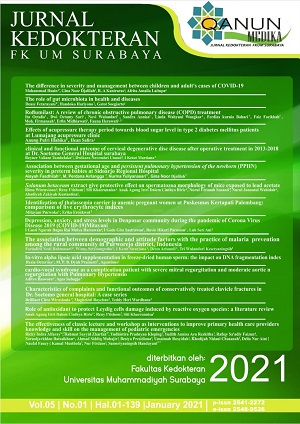Effects of acupressure therapy period towards blood sugar level in type 2 diabetes mellitus patients at Lumajang acupressure clinic
Abstract
Abstract
Â
Diabetes Mellitus is a worldwide metabolic disease and becomes a challenge for the health practitioner. Unfortunately, less than half of these diabetic individuals are aware of their conditions, and less than 1% of those receiving medical treatment achieve their therapeutic targets. Acupressure is an alternative method that is believed to be an effective way of treating diabetic patients with reducing symptoms and complications. This research aims to discover the effect of period acupressure therapy on blood sugar levels in type two diabetes mellitus patients in Lumajang Acupressure Clinic. It uses an observational analytic design with pre-test and post-test approach. It involved 36 participants who were split into two groups and contained 18 participants for each group. The first group received acupressure therapy for three weeks, while the second group received eight weeks. Both groups underwent acupressure at the San Yin Jiao (SP-6) acupoint for 20 minutes three times a week. All participants in both groups had their blood glucose checked before and after acupressure therapy. The results showed that the two groups were significantly different for the paired t-test and the independent t-test. The acupressure therapy period has an effect on decreasing blood sugar levels in type two diabetes mellitus patients at Lumajang acupressure clinic.
Â
Keywords            : Acupressure, the period of therapy, blood glucose level, type two diabetes mellitus
Correspondence  : Anungputri113@gmail.com
Full text article
References
Azitha, M., Aprilia, D., & Ilhami, Y. R. (2018). Hubungan Aktivitas Fisik dengan Kadar Glukosa Darah Puasa pada Pasien Diabetes Melitus yang Datang ke Poli Klinik Penyakit Dalam Rumah Sakit M. Djamil Padang. Jurnal Kesehatan Andalas, 7(3), 400. https://doi.org/10.25077/jka.v7i3.893
Dinkes. (2018). Hasil Utama Riset Kesehatan Dasar Jawa Timur 2018. In Jakarta: Badan Penelitian dan Pengembangan Kesehatan, Kementrian Kesehatan Republik Indonesia.
Feng, Y., Fang, Y., Wang, Y., & Hao, Y. (2018). Acupoint Therapy on Diabetes Mellitus and Its Common Chronic Complications: A Review of Its Mechanisms. BioMed Research International, 2018, 1–9. https://doi.org/10.1155/2018/3128378
Fitrullah, & Rousdy, A. (2017). Effectiveness of Acupressure at the Zusanli (ST-36) Acupoint as a Comfortable Treatment for Diabetes Mellitus: A Pilot Study in Indonesia. JAMS Journal of Acupuncture and Meridian Studies, 10(2), 96–103. https://doi.org/10.1016/j.jams.2016.12.003
Fogarty, S., Smith, C. A., & Hay, P. (2016). The role of complementary and alternative medicine in the treatment of eating disorders: A systematic review. Eating Behaviors, 21, 179–188. https://doi.org/10.1016/j.eatbeh.2016.03.002
Ha, K. H., Kim, D. J., & Kim, S. (2018). Clinical characteristics of people with newly diagnosed type 2 diabetes between 2015 and 2016: Difference by age and body mass index (Diabetes Metab J 2018;42:137-46). Diabetes and Metabolism Journal, 42(3), 251–253. https://doi.org/10.4093/dmj.2018.0099
Kharroubi, A. T. (2015). Diabetes mellitus: The epidemic of the century. World Journal of Diabetes, 6(6), 850. https://doi.org/10.4239/wjd.v6.i6.850
Kosim, M. N., Damayanti, S., & Sucipto, A. (2017). Hubungan Dukungan Sosial Keluarga Dengan Kepatuhan Olahraga Pasien Diabetes Melitus Tipe 2 Di Kelompok Persadia Rs Pku Muhammadiyah Yogyakarta. Universitas Respati Yogyakarta, 12(2), 1–9. https://doi.org/https://doi.org/10.35842/mr.v0i0.86
Lisanawati, R., Hasneli, Y., & Hasanah, O. (2015). Perbedaan Sensitivitas Tangan Dan Kaki Sebelum Dan Sesudah Dilakukan Terapi Pijat Refleksi Pada Penderita Diabetes Melitus Tipe II. JOM, 2(37), 1402–1409. https://doi.org/10.12816/0013114
Meidikayanti, W., & Wahyuni, C. U. (2017). Hubungan dukungan keluarga dengan kualitas hidup Diabetes Melitus Tipe 2 Di Puskesmas Pademawu. Jurnal Berkala Epidemiologi, 5(2), 240–252. https://doi.org/10.20473/jbe.v5i2.2017.240-252
Naja, F., Anouti, B., Shatila, H., Akel, R., Haibe, Y., & Tfayli, A. (2017). Prevalence and Correlates of Complementary and Alternative Medicine Use among Patients with Lung Cancer: A Cross-Sectional Study in Beirut, Lebanon. Evidence-Based Complementary and Alternative Medicine, 2017, 1–11. https://doi.org/10.1155/2017/8434697
Nordström, A., Hadrévi, J., Olsson, T., Franks, P. W., & Nordström, P. (2016). Higher prevalence of type 2 diabetes in men than in women is associated with differences in visceral fat mass. Journal of Clinical Endocrinology and Metabolism, 101(10), 3740–3746. https://doi.org/10.1210/jc.2016-1915
Rachmayanti, A. A., Murbawani, E. A., & Wijayanti, H. S. (2017). Hubungan Asupan Niasin Dengan Kadar Glukosa Darah Puasa Pada Wanita 30-55 Tahun Di Kota Semarang. Journal of Nutrition College, Volume 6, Nomor 3, 184(4681), 227–233. https://doi.org/10.1038/184156a0
Ramachandran, A. (2014). Know the sign and symptoms of diabetes. Indian Journal of Medical Research, 140(5), 579–581. https://www.ncbi.nlm.nih.gov/pmc/articles/PMC4311308/?report=printable
Risnasari, N. (2014). Hubungan Tingkat Kepatuhan Diet Pasien Diabetes Mellitus dengan Munculnya Komplikasi di Puskesmes Pesantren IIKota Kediri. Efektor, 01(25), 15–19.
Sugiyono. (2008). Metode penelitian pendidikan:(pendekatan kuantitatif, kualitatif dan R & D). Alfabeta.
World Health Organization. (2016). World Health Day 2016: WHO calls for global action to halt rise in and improve care for peoplewith diabetes. WHO. https://www.who.int/diabetes/global-report/WHD16-press-release-EN_3.pdf?ua=1
Xu, G., Liu, B., Sun, Y., Du, Y., Snetselaar, L. G., Hu, F. B., & Bao, W. (2018). Prevalence of diagnosed type 1 and type 2 diabetes among US adults in 2016 and 2017: Population based study. BMJ (Online), 362. https://doi.org/10.1136/bmj.k1497
Zarvasi, A., Ansari Jaberi, A., Negahban Bonabi, T., & Tashakori, M. (2018). Effect of self-acupressure on fasting blood sugar (FBS) and insulin level in type 2 diabetes patients: a randomized clinical trial. Electronic Physician, 10(8), 7155–7163. https://doi.org/10.19082/7155
Zick, S. M., Sen, A., Wyatt, G. K., Murphy, S. L., Todd Arnedt, J., & Harris, R. E. (2016). Investigation of 2 types of self-Administered acupressure for persistent cancer-related fatigue in breast cancer survivors a randomized clinical trial. JAMA Oncology, 2(11), 1470–1476. https://doi.org/10.1001/jamaoncol.2016.1867
Authors

Qanun Medika by FK UM Surabaya is liscence under Lisensi Creative Commons Atribusi 4.0 Internasional.

